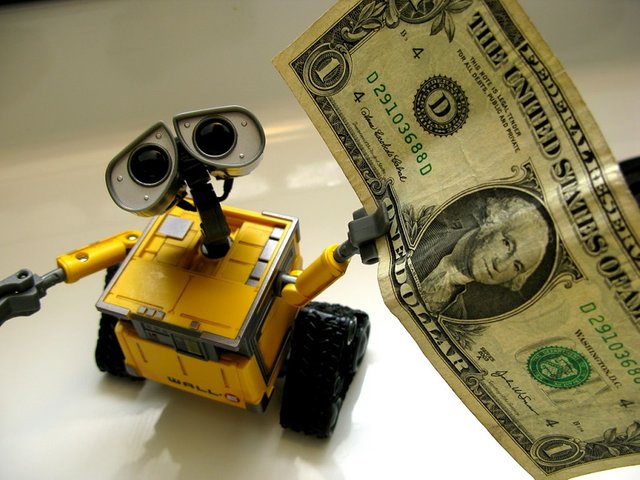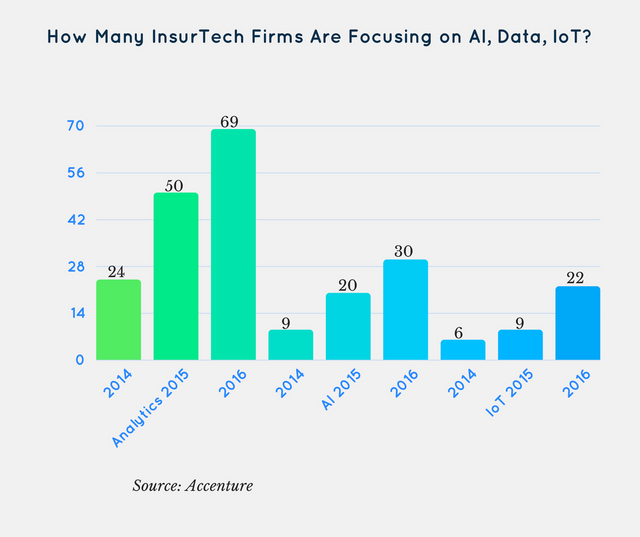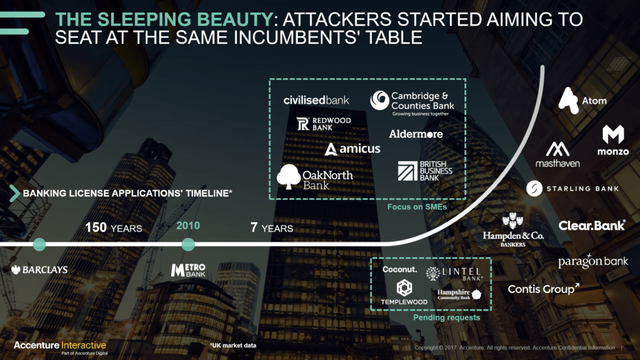How Many Robots Does it Take to Change a Financial System?
Analysing the Top 10 Areas in Finance where AI is Changing the Game, Now!
Oh Sh&^ the Robots are Here...
AI is already impacting the world on a grand scale with a record $5 billion being invested in AI startups in 2016 alone. This impact is confounded within the world of Finance, according to McKinsey, ranking second only to High Tech & Communications. CEO’s of major banks are now touting themselves as being technology companies instead financial services companies. In Finance circles, Whattsapp groups and email threads have lit up with questions about the impact that AI is having within financial services. Questions such as: “Is our role safe from those Robo Advisors?”, “ Will the robots really be taking over our jobs soon?” and “How can we better position ourselves to remain relevant in the new world run by Terminator?” have been common, for the most part. The reason why this is already happening is covered in the previous article in this two part series. The remainder of this article will focus on analysing where AI is already having the most impact in Finance and what the impact will be, so that one can better position oneself for the oncoming disruptive wave.

Source: https://siliconangle.com/blog/2016/05/31/which-finance-jobs-are-safe-from-robots-and-automation/
How Do Robots Impact Us?
Before unpacking the most common areas of AIs impact, it is important to better understand the types of impact that AI can have. AI comes in various forms and it can be utilised in various ways - below is a list of the four ways in which AI can and will be utilised by humans:
Augmenting - Intelligence Augmentation is one of the more common ways for AI to impact our workplace and places us humans at the center of this interaction with smart technology. Through the cognitive collaboration of our current workflows, we can use technology to enhance our performance and efficiency. Examples of this form include intelligence amplification tools such as Microsoft’s HoloLens.
Assisting - Instead of augmenting our abilities, these forms assist with the tasks at hand in a dependant way. They are designed to perform whole tasks that aid us in a way that does not necessarily require collaboration, but rather use. The world of Regtech provides great examples of this form, such as the ML enhanced tamper detection for fraudulent documents offered by ComplyAdvantage and the many other AI enhanced anti-money laundering (AML) solutions on offer. An interesting example of this is that of the Unmanned Autonomous Vehicles (UAVs) used by Orbital Insight’s team to formulate capital market Analysis.
Independent (Single Focus) - These forms of AI focus purely on assisting in doing tasks outright. A step up from the aforementioned forms, this form of AI operate more independently to human beings and is becoming more common in Financial Services circles. The best examples of this form is that of the robo-advisors and the quant funds’ trading algorithms.
Independent (Broad focus) - Super AI is still a long way away. As far as we can predict, this form of AI effectively replaces human beings in almost all use cases that don’t require empathy, creativity and accurate, meaningful emotional responses.
“Artificial intelligence can help people make faster, better, and cheaper decisions. But you have to be willing to collaborate with the machine, and not just treat it as either a servant or an overlord.” - Anand Rao PwC Innovation Lead, Analytics
(Source: https://www.pwc.com/us/en/financial-services/research-institute/artificial-intelligence.html)
How Many Robots Does it Take to Change a Financial System?
There is no need to panic, just yet. As Roy Amara’s law states - we often tend to overestimate the impact of a new technology in the short term, but underestimate its impact over the long term. The below list provides an overview of the 10 areas where AI is impacting Finance the most, now.

Wealth Management
1. Robo-Advisors & Portfolio Management
Wealth Management is an obvious place to start as there is a clear view on the impact that AI is already having via robo-advisors within the space. Will wealth managers be replaced entirely, or will there be a hybrid of augmentation and assistance allowing for new improved services to be offered? According to BI Intelligence Robo Advisors will have captured approximately 10% share of the total global Assets Under Management (AUM) pool, equating to $8 trillion, by 2020. Furthermore, robo-advisors (RAs) offer a few key advantages, making them an evermore attractive alternative:
Cost - RAs offer lower fees, with equal returns.
Tax Optimisation - Some RAs include tax optimisation benefits that outperform traditional advisors’ optimisation schemes.
Less Friction - Automation of admin related process allows for a frictionless use case.
Optimised Returns - As RAs become more sophisticated, they offer better optmisation of portfolio returns than a human can, given the same mandate.
2. Algorithmic Trading (Quants)
Not only are traditional advisors being replaced by robo-advisors, but traders and investment managers are being replaced by quants, with the Wall Street Journal stating that they now control about a third of all trading on U.S stock markets today. AI is being used in abundance within the wealth management sector, it provides managers and advisors with the tools required to scan vast amounts of data and to provide valuable insights.
3 Good Examples of AI in Wealth Management
UBS’ SmartWealth
Wealthfront’s Robo Advisors
Blackrock’s Aladdin
Analysis
The strength of AIs prediction engines will be leveraged across the industry in terms of communications, planning and portfolio management and trading. Financial services firms will start to let go of traditional money managers and back office staff to be replaced by more data scientists, AI specialist developers and creative financial managers to stay ahead of the curve. RAs will replace and augment wealth advisors in the short term and will gain close to a 75% total market share of AUM by 2030. Quants will run at least 75% of the market by 2025.

Source: BI Intelligence
Regulatory Compliance
3. Fraud Detection & Client Onboarding
4. Risk-Data Aggregation
5. Stress Testing
The sheer enormity of the tasks that make up regulatory compliance leaves most with the shivers - except those familiar with effective Regtech (Regulation Technology) solutions powered by AI. The The Institute of International Finance prescribes that AI empowered Regtech solutions can identify complex nonlinear patterns in large data sets to create more accurate risk models. From scanning troves of new account applications to spot fraudsters, to enabling compliance teams with the data crunching tools that they need, AI is powering Regtech, this subset of Fintech, in a meaningful way. Key advantages include:
Speed - An obvious strength is the ability to scan enormous amounts of data to pick up on the necessary trends/anomalies.
Accuracy - Humans get tired, humans make errors - robots do not, unless a human did.
Cost Efficiency - Reducing manual processing hours represents a material benefit to the bottom line. Less errors (see above) also represents a saving for the business employing AI powered Regtech.
Stress Testing - Stress testing various thresholds in different scenarios is an invaluable resource for banks to call upon.
Enhanced Prevention - Preventing rogue traders, dangerous content and fraudsters in a way that a human cannot is the name of the game.
3 Good Examples of AI in Regtech
Feedzai’s hypergranular risk profiles
DarkTrace’s preventative solutions identifies threats in advance
Neurensic’s SCORE compliance solution
Analysis
The onerous regulatory compliance requirements that continue to grow for financial services firms will be countered by the rise of Regtech solutions. Regtech will continue to empower compliance teams in the short term and will eventually replace many back-office positions - especially those mundane and admin intensive roles. The theme of change will favour legal and compliance teams that are technically savvy, have the necessary creative foresight and an ability to leverage the rapid innovation necessary to keep costs down, systems running smoothly and regulation in check. The current 10% - 15% staffing component of financial services businesses dedicated to regulatory compliance will fall to 1% - 2% by 2025. New positions for technically savvy layers and compliance managers will open up to guide the digitalisation agenda of the financial services firm.
Insurance
6. Automated, Augmented Underwriting & Loss Prevention
7. Claims Process & Fraud Detection
According Accenture, the number of Insurtech funding deals related to AI more than tripled from nine deals in 2014 to thirty deals in 2016. Insurance, being a game that is all about data and Analysis, is a natural fit for AI. From the many touch points including social media data, application text data, sensor data, image data and even call center voice data; insurers are now able to employ ML and Bayesian Learning techniques to enhance the underwriting and claims processes.

Key advantages:
Personalised - From chatbots to AI powered claims engines, insurers are now able to provide the personalisation that modern consumers demand.
Smarts - Interconnected, real-time, sensor driven systems enable smarter risk selection and assessments.
Cost - Significantly lower onboarding and admin costs translate into substantially lower rates to the consumer. More information from interconnected systems (see above) also equals lower premiums, for those deserving of them.
Speed - Less administrative, digital first, AI powered systems are lightning fast compared to their ancestors.
3 Good Examples of AI in Insurance
Lemonade’s personalised insurance
Captricity makes data work better for insurance companies
Tractable Insurance’s accurate, AI enhanced motor claims
Analysis
The insurance industry will be mostly run by AI and encapsulated code by 2035. IoT will have a generous impact on the industry, supplanting current methodologies for analysing risk. AI will replace traditional actuarial roles and create new business models that empower inclusion and enable enhanced risk, more beneficial risk pools that benefit the consumer. Creative insurance products will create many new industry silos and will pervade all aspects of life from a micro to a macro scale. Real-time, adaptive, optimised automated insurance products will become the norm, followed by insurance being built into products top drive the sharing economy forward - enabled by integrated AI-powered systems.
“The first machine age, the Industrial Revolution, saw the automation of physical work. We live in the second machine age, in which there is increasing augmentation and automation of manual and cognitive work.” PWC, AI in insurance: Hype or Reality?
Banking
8. Personalised Product Recommendations
9. Personalised Financial Management & Spend Forecasting
10. Cybersecurity
There isn’t a more intriguing space to watch in terms of the impact that Fintech is having than within the banking sector. Open Banking is here and is changing the face of banking forever. Banks are investing heavily into new technologies in an attempt at transforming along with the rapidly changing landscape. Some banks will survive, in some form or another, some banks will die, in a flurry of high fees and poor customer service. Those banks that succeed, will have mastered implementing AI powered solutions within the short term.
3 Good Examples of AI in Banking
Starling Bank’s personalised banking approach
SoFi’s personalised product offerings
Atom’s AI-powered customer service
Analysis
It’s about survival now! Banks will have to transform their entire business model to adapt to the new technologies and customer demands at play and to avoid becoming a mere vestigial part of the financial services sector. Banks will still have their place in the system, but will operate more as financial technology service providers, financial services product aggregators and ‘data brokers’ in order to survive and thrive. No more traditional banks as we know them today, bank branches will cease to exist, globally, by 2035. AI will drive change across front, middle and back office roles as banks transform to fit new regulations, new consumer demands and new competing business models.

Source: Accenture Interactive
###"I don't trust banks. I believe when the robots rise up, ATMs will lead the charge." – Sheldon Cooper, The Big Bang Theory
AI’ll Be Back
Despite us entering terra incognita, AI won’t be completely replacing all jobs just yet. We will, however, be seeing enormous change and transformation within the industry and across numerous roles. Just as the digital wave transformed traditional media where it left a litany of jobs irrelevant - it created even more positions, with a net positive result in employment and effectiveness of media channels.
Some important caveats to the speed and efficacy of this AI-led transformation include:
Data & Human Risk - Garbage in, garbage out lends itself to ofttimes difficult to detect data risk. There is also the risk that we don’t actually know what we’re doing, most of the time, with early-stage AI - not all AI is good AI.
Training - There is still a long way to go when considering how much training is still required for AI systems to perform at the level of humans.
Economics - As the old myth goes, Steve Jobs had the iPhone in his back pocket when he gave the world the first look at the iPod. Simple economics have always dictated slow release of technology, to extract as much return on each iteration.
Regulation - Regulators are already struggling to keep up with the frenetic pace of digital transformation. Regulating AI will be even more challenging and ‘grey’ in nature.
Skill Set - AI still has a lot of catching up to do when it comes to:
1.) Empathy
2.) Adaptability
3.) Intuition
4.) Creativity
5.) Epistemology
6.) Reasoning/Judgement
In closing, an apt quote from Tim O’Reilly: “What we now call AI is just the next stage of us weaving our intelligence together into a greater whole. If you think about the internet as weaving all of us together, transmitting ideas, in some sense an AI might be the equivalent of a multicellular being and we’re its microbiome, as opposed to the idea that an AI will be like the golem or the Frankenstein...We tend to be afraid of new technology and we tend to demonize it, but to me, you have to use it as an opportunity for introspection. Our fears ultimately should be of ourselves and other people."
Thank you to Huy Nguyen Trieu and the CFTE team for providing the foundational knowledge through their new LMS that guided the creation of this article.


